The Civil War novel that tops "Gone With The Wind"

And as they reached that low stone wall, one story in particular was told: That of a Confederate general named Lewis Armistead, a man who had a friend who virtually could be his brother they were so close. That friend was a proud soldier named Winfield Scott Hancock. A general himself in this war whose troops, alas, did not march beside Armistead's but instead lay in wait at that wall. As the boys in blue and grey battled around the copse of trees, Hancock’s friend fell mortally wounded. The tragic story brought tears to the father’s eyes.
Little did they know that the father would later movingly depict Armistead’s death in a magnificent novel entitled The Killer Angels. Nor did they know that on a summer morning in 1992 from out of the woods on Seminary Ridge would emerge soldiers in grey and butternut uniforms. Rifle-muskets at right shoulder arms with fixed bayonets and carrying either the square Southern Cross battle flag or the Stainless Banner CSA national flag. Officers riding in front or marching on foot flourishing their swords or doffing their hats as they passed cheering gunners at a long row of cannon. All present bringing that novel to life upon this hallowed ground for movie cameras. Cameras present for the filming of the movie version of Michael Shaara’s masterpiece.
When Michael sat down to start writing The Killer Angels, a remarkable thing happened. Instead of creating a group of fictional characters to weave into actual history, Shaara opted to create only one, a minor supporting character named Kilrain. He chose instead to use historical characters as the novel’s cast. A remarkable decision, since usually such casting had been confined to biographical fiction such as Irving Stone’s The President’s Lady. The very fact that Michael was even writing historical fiction was unique. His main focus in his writings had been science-fiction and detective short stories as well as one full-length work of literary fiction entitled The Broken Place. But the stories of Gettysburg compelled him to try a new genre.
As he delved into his research, the stories of various other personalities called out to him in the same way Armistead's had. Soon the Confederate side was represented by Lew Armistead, Robert E. Lee and James Longstreet, along with their supporting historical characters such as John Bell Hood, George Pickett, etc. The story of British Army observer Arthur Freemantle won him a spot as a central character too. The stories of John Buford and Joshua Chamberlian won them spots as the Union characters.
Michael did not skimp on his research. While he did condense some minor events together and eliminate a few supporting historical characters, he hewed faithfully to the known facts overall. He even took pains to mention in a note to readers at the start of the book that he had condensed events and eliminated some minor characters. Despite this, The Killer Angels has been damned with faint praise from some scholarly quarters such as in this example. Other scholars such as James M. McPherson however, have had nothing but praise for it.
Unfortunately, the journey to publication was a tortured one. Eighteen times the book was rejected until it at last appeared in 1974. Critical reaction was respectful but sales lukewarm. But then in a stunning twist, the book won the Pulitzer Prize for fiction. While sales remained so-so, the ultimate in critical helped keep The Killer Angels in print.
When filmmaker Ronald F. Maxwell read it, it fueled a desire to make the adaptation that witnessed those Civil War re-enactors marching on the hallowed fields of Gettysburg. His film version (entitled Gettysburg to avoid confusion as to its subject matter) finally made The Killer Angels a best-seller. Sadly, Michael passed away before the film version of his masterpiece was released. Yet his novel is now hailed as a true classic. His son Jeff also became a writer and wrote a well-received prequel and sequel to it.

The Killer Angels is superior to Gone with the Wind as a Civil War novel. Margaret Mitchell's book is a classic of literature, yes, and truly a great American novel. But it is one whose focus is on the life and loves of a Southern belle named Scarlett O'Hara before, during, and after the Civil War. It is not, strictly speaking, about the war itself since it forms but a backdrop to Scarlett's story.
The Killer Angels, by contrast, is about the Civil War. Not only because of Michael Shaara's fidelity to history but how well he brought the real-life historical characters who fought at Gettysburg to life. What is more, via the stories of the likes of Hancock and Armistead, he depicted the sheer madness of it all. What could be more insane than a war which sets friend against friend?
If you have not already read The Killer Angels yet, this year would be a good time. This year marks the 150th of the battle of Gettysburg. And if you have read this masterpiece, feel free to give a comment or shout.
Main article image courtesy Wikimedia Commons
Second image courtesy of Goodreads
2 comments